Live Event: Open Enrollment for Machine Safety Specialists (MSS) Virtual Machine Safety and Risk Assessment Training Class. Click Here to enroll today!
Unbiased Risk Assessments are guided by safety experts that have your best interests in mind. Product companies, integrators, and solution providers may steer you toward expensive, overly-complex technical solutions. Machine Safety Specialists provides unbiased Risk Assessments. See examples below.
Biased risk assessments can happen when a safety products company, integrator, or solution provider participates in the risk assessment. The participant has a conflict of interest and may steer you towards overly expensive or complex solutions that they want to sell you. Some safety product companies will do anything to get involved in the risk assessment, knowing they will “make up for it” by selling you overly expensive solutions. Safety product companies have sales targets and you could be one of them.
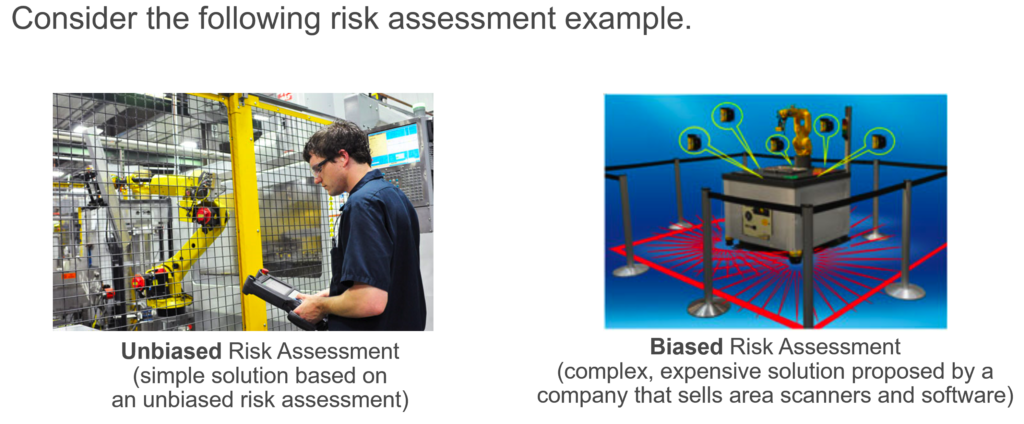
Machine Safety Specialists are experts in OSHA, ANSI, NFPA, RIA and ISO/EN safety standards. We can solve your machine safety compliance issues, provide unbiased Risk Assessments, or help you develop your corporate Machine Safety and Risk Assessment program.
A multi-national food processing company had a problem. A recent amputation at a U.S. food processing plant generated negative publicity, earned another OSHA citation, and caused significant financial losses due to lost production. Another amputation, if it occurred, would likely result in more lost production, an OSHA crackdown, and, if posted on social media, irreparable damage to the company’s brand.
After multiple injuries and OSHA citations, the company contacted MSS for help. First, the company needed to know if the existing machine safeguarding systems provided “effective alternative protective measures” as required by OSHA. MSS was contracted through the company’s legal counsel to audit three (3) plants with various type of machines and deliver detailed Machine Safety compliance reports for each machine to the client under Attorney Client Privilege. A summary in our safeguarding audit reports for one plant was as follows:

For the 19 high risk and 8 medium risk (poorly guarded) machines, action by applying risk reduction measures through the use of the hierarchy of controls was required. MSS provided a Machine Safeguarding specification for the machines and worked with our client to select qualified local fabricators and integrators that performed the work in an aggressive schedule. MSS provided specifications and consulting services, and our client contracted the fabrication and integration contractors directly, under the guidance of MSS.
During the design phase of the Machine Safeguarding implementation, MSS provided safety verification services and detailed design reviews. Due to the stringent legal requirements and the need for global compliance, the safety design verification included SISTEMA analysis of the functional safety systems. MSS provided a detailed compliance report with written compliance statements covering OSHA compliance, hazardous energy controls (Lockout/Tagout, LOTO, OSHA 1910.147) and effective alternative protective methods, per OSHA’s minor servicing exception. Due to the complexity of the machines and global safety requirements, MSS verified and validated the machine to numerous U.S. and international safety standards, including ANSI Z244.1, ANSI B11.19, ANSI B11.26, ISO 14120, ISO 13854, ISO 13855, ISO 13857 and ISO 13849.
Then, after installation and before placing the machines into production, MSS was contracted to perform safety validation services as required by the standards. During the validation phase of the project, MSS traveled to site to inspect all machine safeguarding and validate the functional safety systems. This safety validation included all aspects of the safety system, including barrier guards, interlocked barrier guards, light curtains, area scanners, the safety controllers and safety software, safety servo systems, variable frequency safety drives (safety VFDs), and pneumatic (air) systems.
After the machine safeguarding design verification, installation, and safety system validation, MSS was pleased to provide the following data in the executive summary of the report.

By involving Machine Safety Specialists (MSS) early in the project, we can ensure your project complies with OSHA, ANSI/RIA, NFPA and ISO safety standards. By helping you implement the project, we kept the safety project on-track. Our validation testing and detailed test reports provide peace of mind, and evidence of due diligence if OSHA pays you a visit. Contact MSS for all of your Machine Safety Training, Safeguarding Verification, and on-site functional safety validation needs.
A global OEM needed to automate 30 existing manufacturing lines across 12 plants. 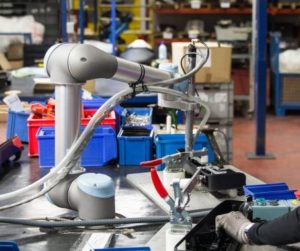 The OEM selected Collaborative Robot (“Cobot”) technology due to Cobots’ simplicity, flexibility, and presumed safe operation. To implement the Collaborative Robot systems, they chose a custom machine builder that accelerated the schedule by taking exception to supposedly nebulous “safety standards”. Six weeks later, the machine builder delivered a seemingly impressive Collaborative Robot assembly system to the plant. Engineers quickly completed commissioning and the Collaborative Robot system went into production. As the Collaborative Robot worked in close proximity to the plant associates, troubling questions weighed on the project team….
The OEM selected Collaborative Robot (“Cobot”) technology due to Cobots’ simplicity, flexibility, and presumed safe operation. To implement the Collaborative Robot systems, they chose a custom machine builder that accelerated the schedule by taking exception to supposedly nebulous “safety standards”. Six weeks later, the machine builder delivered a seemingly impressive Collaborative Robot assembly system to the plant. Engineers quickly completed commissioning and the Collaborative Robot system went into production. As the Collaborative Robot worked in close proximity to the plant associates, troubling questions weighed on the project team….
The OEM called Machine Safety Specialists (MSS) to solve these concerning problems. Prepared to help, our TÜV certified Machine Safety engineers discussed the Collaborative Robot system, entered an NDA, and requested system drawings and technical information. On-site, we inspected the Collaborative Robot, took measurements, gathered observations and findings, validated safety functions, and spoke with various plant personnel (maintenance, production, EHS, engineering, etc.). As part of our investigation, we prepared a gap analysis of the machine relative to RIA TR R15.606, ISO 10218-2, OSHA, ANSI, and ISO standards. The final report included Observations, Risk Assessments, and specific corrective actions needed to achieve US and global safety compliance. Examples of our findings and corrective actions include:
With corrective actions complete, we re-inspected the machine and confirmed all safety settings. MSS provided a Declaration of Conformance to all applicable US and global safety standards. The customer then duplicated the machines and successfully installed the systems at 12 plants globally, knowing the machines were safe and that global compliance was achieved. Another success story by MSS…
A US manufacturer was attempting to automate a complex task – assembly of an elastic sheet in a complex frame, then cutting it precisely. This process 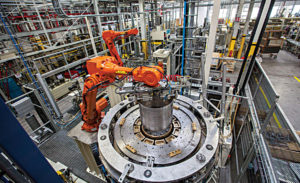 required 16 people across four US plants, and the manual process simply could not keep up with orders. In addition, due to employee fatigue, quality issues were frequent and senior management demanded a solution. The project team’s first challenge? How to develop a custom robot cell and deliver it in a tight schedule.
required 16 people across four US plants, and the manual process simply could not keep up with orders. In addition, due to employee fatigue, quality issues were frequent and senior management demanded a solution. The project team’s first challenge? How to develop a custom robot cell and deliver it in a tight schedule.
The manufacturer hired a robotics integrator and a brief engineering study determined that speed and force requirements required a high-performance Industrial Robot (not a Cobot). The client issued a PO to the integrator, attached a manufacturing specification, and generically required the system to meet “OSHA Standards”. Within 3 months, the robot integrator had the prototype system working beautifully in their shop and was requesting final acceptance of the system. This is when the second problem hit – the US manufacturer experienced a serious robot-related injury.
In the process of handling the injury and related legal matters, the manufacturer learned that generic “OSHA Standards” were not sufficient for robotic systems. To prevent fines and damages in excess of $250,000, our client needed to make their existing industrial robots safe, while also correcting any new systems in development. The manufacturer then turned to Machine Safety Specialists (MSS) for help.
Prepared to help, our TÜV certified and experienced robot safety engineers discussed the Industrial Robot application with the client. MSS entered an NDA and a formal agreement with the client and the client’s attorney. On-site, MSS inspected the Industrial Robot system, took measurements, gathered observations and findings, tested (validated) safety functions, and met with the client’s robotics engineer to complete a compliance checklist. As part of our investigation, we prepared a Risk Assessment in compliance with ANSI/RIA standards, an RIA compliance matrix, and performed a gap analysis of the industrial robot systems relative to ANSI/RIA standards. The final report included a formal Risk Assessment, a compliance matrix, our observations, and specific corrective actions needed to achieve safety compliance.
Examples of our findings and corrective actions included:
With corrective actions complete, MSS re-inspected the machine, verified safety wiring, validated the safety functions and provided a Declaration of Conformance for the robot system. The customer then accepted the system, commissioned, and placed it into production. The project was then deemed a huge success by senior management. The industrial robot system now produces high-quality assemblies 24/7, the project team feels great about safety compliance, and the attorneys are now seeking other opportunities. Another success story by MSS…
Background: A safety products company was contracted to perform a risk assessment.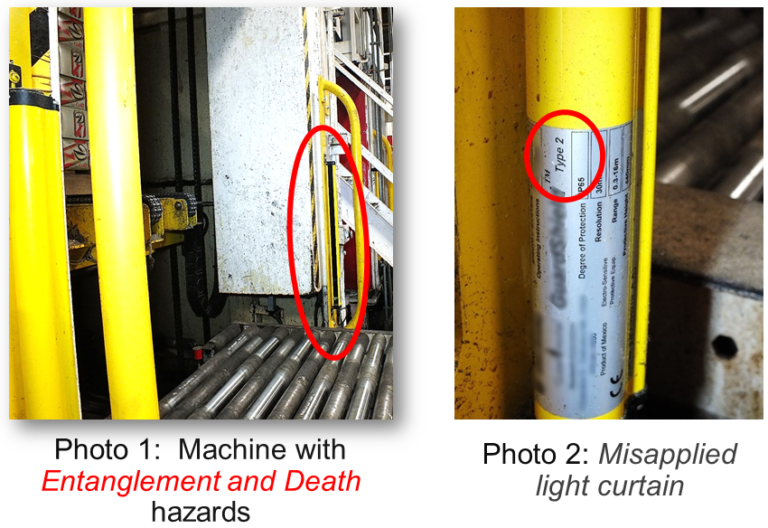 Result: The most expensive products and solutions were recommended by the product company. The client purchased and installed the materials, resulting in an improper application of a safety device. The hazard was not effectively abated. The Employer’s liability existed until MSS identified the problem, the light curtain was replaced, and the system was validated. Machine Safety Specialists specified the correct light curtain and a compliant, cost-effective solution was finally installed. This really happened – Don’t let it happen to you !
Result: The most expensive products and solutions were recommended by the product company. The client purchased and installed the materials, resulting in an improper application of a safety device. The hazard was not effectively abated. The Employer’s liability existed until MSS identified the problem, the light curtain was replaced, and the system was validated. Machine Safety Specialists specified the correct light curtain and a compliant, cost-effective solution was finally installed. This really happened – Don’t let it happen to you !
Q: Which safety product company do we trust to perform a risk assessment with your best interest in mind? A: None of them. Companies selling safety products have a hidden agenda – sell the most products and charge insane dollars for installation! Machine Safety Specialists are safety engineers and consultants who have your best interest in mind. We will conduct an unbiased Risk Assessment and recommend the most sensible, lowest cost, compliant safeguards on the market – with no hidden sales agenda!
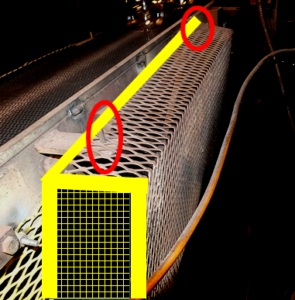
“Wow – This Customer needs $50K of functional safety equipment on each machine. Add light curtains, safety system, software, etc….”. Problem solved for $50,000.
“Bolt down the existing guard, add end cap, remove sharp edges and secure the air line. Add a warning sign with documented training….”. Problem solved for $50. Once again, this really happened – don’t let it happen to you !
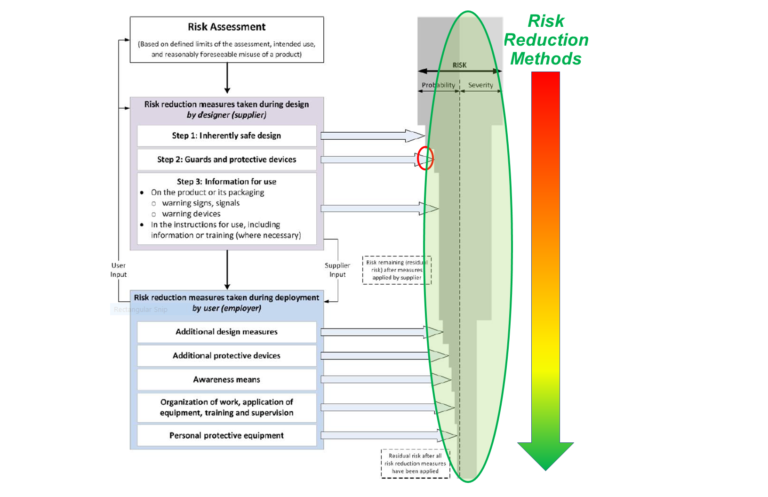 risk reduction ensured the most complete, sensible, and least expensive solution for compliance” – Safety Manager
risk reduction ensured the most complete, sensible, and least expensive solution for compliance” – Safety ManagerGreen Circle (right): We use all methods of Risk Reduction (elimination, signs, training) – not just guards and protective devices. This is the least expensive and most comprehensive approach. Red Circle (right): Guarding company methods of risk reduction (guards and protective devices) are very expensive, time consuming, and do not mitigate all of the risk.
Another frequently asked question is: “Why do I need a Risk Assessment?” To answer this, please see Case Study: “Applicable U.S. Machine Safety Codes and Standards”, then please see below… Why Perform a Risk Assessment? A written workplace hazard assessment is required by law. In section 1910.132(d)(2), OSHA requires a workplace hazard analysis to be performed. The proposed Risk Assessment fulfils this requirement with respect to the machine(s).
1910.132(d)(2): “The employer shall verify that the required workplace hazard assessment has been performed through a written certification that identifies the workplace evaluated; the person certifying that the evaluation has been performed; the date(s) of the hazard assessment; and, which identifies the document as a certification of hazard assessment.”
A Risk Assessment (RA) is required by the following US standards:
Please note the following excerpt from an actual OSHA citation:
“The machines which are not covered by specific OSHA standards are required under the Occupational Safety and Health Act (OSHA Act) and Section 29 CFR 1910.303(b)(1) to be free of recognized hazards which may cause death or serious injuries.”
In addition, the risk assessment forms the basis of design for the machine safeguarding system. The risk assessment is a process by which the team assesses risk, risk reduction methods, and team acceptance of the solution. This risk reduction is key in determining the residual risks to which personnel are exposed. Without a risk assessment in place, you are in violation of US Safety Standards, and you may be liable for injuries from the un-assessed machines.
Contact Us Today for your Free Risk Assessment Spreadsheet
We are often asked: “What must I do for minimum OSHA compliance at our plant? Do I have to follow ANSI standards? Why?” The following information explains our answer… Please note the following excerpt from an actual OSHA citation:
“These machines must be designed and maintained to meet or exceed the requirements of the applicable industry consensus standards. In such situations, OSHA, may apply standards published by the American National Standards Institute (ANSI), such as standards contained in ANSI/NFPA 79, Electrical Standard for Industrial Machinery, to cover hazards that are not covered by specific OSHA standards.”
U.S. regulations and standards used in our assessments include:
Please note the following key concepts in the U.S. Safety Standards:
Note: OSHA is now citing for failure to meet ANSI B11.19 and NFPA 79.